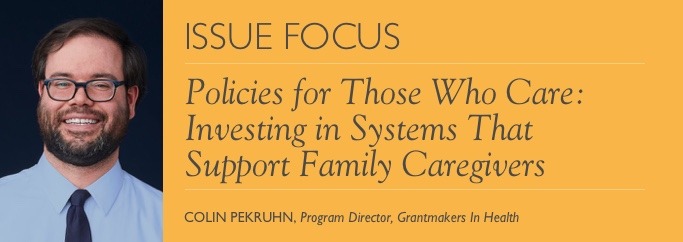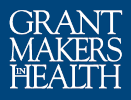September 2019

Colin Pekruhn, Program Director, Grantmakers In Health
Across the country, more than 45 million family members are providing care for older adults with chronic, disabling health conditions. There are a multitude of reasons why health grantmakers should be concerned about this, ranging from caregivers’ critical role in managing the needs of complex care patient populations to the manifold short- and long-term impacts caregiving has on the health and wellness of caregivers themselves—impacts that, with time, will be exacerbated by the rapidly shrinking pool of potential caregivers (Pekruhn 2017). Beyond the immediate caregiving relationship, there are broader implications for communities as a whole (Khasawinah 2019).
Opportunities for funders to improve caregivers’ ability to provide care for their loved-ones and themselves were explored as part of a Grantmakers In Health (GIH) and Grantmakers In Aging (GIA) convening in 2017 (see “Supporting Older Adults and Family Caregivers” for a summary). But there remains a tremendous need for grantmakers to support efforts that transform policies at the federal, state, and local levels to better reflect the fact that family caregivers are an important part of the care system. In March 2019, GIH and GIA cohosted a second strategic conversation of funders focused on the current state of family caregiving policy and efforts to create new and innovative policies across the country. The dialogue covered a wide variety of topics; the following are some important highlights for grantmakers to consider.
“Hyper-Local” Policy Action
There are both explicit (e.g., leave for family caregivers) and implicit (e.g., social services for seniors) opportunities to make a difference for family caregivers and their care recipients. While there have been significant successes at the national level (i.e., Recognize, Assist, Include, Support, and Engage (RAISE) Family Caregivers Act) and state level, (e.g., 39 states adopting the AARP Caregiver Advise, Record, Enable (CARE) Act model policy), changes in federal and state funding can be difficult to attain (AARP 2019). In such cases, there may be more room for “hyper-local” policy action; that is, action at the city and county policy levels.
Contrary to public perception, funding for older adult services has been flat and not kept pace with cost-of-living increases. At the local level, this means that county budget earmarks and tax levies for health and social support services are an area that funders might consider for engagement. In Ohio, for example, 85 percent of the state’s counties have levied a property tax to support senior services. In San Francisco, citizens voted in 2016 to establish a $38 million Dignity Fund to supplement existing services funding by focusing on unmet and emerging service needs of seniors and adults with disabilities (Kelly 2019). This was in direct response to reports and data, spearheaded by a coalition that was critical in the Fund’s passage, that documented significant inequities in access to existing services. The coalition included the San Francisco AIDS Foundation and numerous other community organizations.
Working locally, funders have several options. For example, in addition to traditional policymaker education and local coalition-building efforts, grantmakers can fund local data collection and predictive data analysis efforts. In many cases, communities do not have the data needed to understand the needs of older adults and their caregivers. Where there is data available, very little has been done to use it to understand and predict future needs and gaps in the elder care system. Such efforts would be vital to making the case for hyper-local policy efforts.
Integrating Family Caregiving into Existing Priorities and Systems
Finding ways to align the needs of caregivers with other efforts is an important strategy to consider, given competing policy priorities. This is one of the strategies the Helping States Support Families Caring for an Aging America initiative is pursuing. The initiative, supported by The John A. Hartford Foundation, Milbank Memorial Fund, May & Stanley Smith Charitable Trust, and Gordon and Betty Moore Foundation, is supporting state-level technical assistance and learning to assist family caregivers across six states: Alabama, Idaho, Iowa, New Hampshire, South Carolina, and Virginia. Working with these states, some of the potential areas they have identified to align with include Medicaid expansion and the creation/development of managed long-term services and supports programs (Roman 2019).
Another effort receiving support from practitioners, advocates, and funders, including the grantmakers previously mentioned, is improved integration of family caregivers into the health care system. This includes recognizing them as an important and valuable member of a care team or working with Medicare Advantage plans. For example, the Stupski Foundation has been supporting efforts in San Francisco to develop models for integrating family caregivers into medical teams (Kelly 2019).
Capitalizing on Public-Private Partnership Opportunities
There are many opportunities for funders to team up with federal partners, both nationally and at the state and local levels. The Administration for Community Living (ACL) is one of the federal agencies that is actively undertaking public-private partnerships. For example, ACL is co-funding or co-administering programs with The John A. Hartford Foundation, San Francisco Foundation, Gray and Mary West Health Foundation, The SCAN Foundation, The Colorado Health Foundation, and Buck Family Fund at Marin Community Foundation among many others. These partnerships are often sought out because they are required by the Older Americans Act and the RAISE Family Caregivers Act. They are used to (co-)convene important stakeholders; find matches for federal grant opportunities; help inform, support, and observe current and future initiatives; and co-fund/administer projects (Link 2019).
The Aging and Disability Business Institute is an example of these partnerships. Administered by the National Association of Area Agencies on Aging (N4A), ACL is engaged with several non-profit and philanthropic partners to help community-based service organizations, including many that serve family caregivers, adapt and thrive in a changing health care environment. Other examples include working with funders and other private partners to (co-)convene stakeholders to address elder abuse in rural and frontier communities and to help grantees raise matching dollars for federal grant initiatives like the Lifespan Respite Care Program (Link 2019).
There is strong interest in creating a roadmap for public-private partnership. With funding from the Robert Wood Johnson Foundation, in 2018 the National Alliance for Caregiving hosted a multistakeholder summit on Public-Private Innovation in Family Caregiving. The goal was to find a way forward for the establishment of a publicly and privately supported innovation fund for caregiving research to accelerate change in addressing the needs of family caregivers. The summary report provides a road map that outlines roles for the federal government and private philanthropy (Marshall 2019; Wagner and Hunt 2018).
The ACL and local Area Agencies on Aging (AAAs) are also looking for help sustaining and expanding existing programs and demonstrations, such as those funded under their National Family Caregiver Support Program, replicating/translating proven interventions, testing new and emerging care models, and scaling up smaller demonstration projects (Link 2019).
Building on National Momentum
In 2016, the National Academies of Sciences, Engineering, and Medicine report, Families Caring for an Aging America, offered a number of recommendations to improve support for family caregivers. The first recommendation, calling for the creation of a national strategy, has been realized as part of the federal RAISE Family Caregivers Act of 2018. In addition, the Act creates the Advisory Council on Family Caregiving that will make recommendations to the Secretary of Health and Human Services about effective models of family caregiving and support to family caregivers and improved coordination across federal government programs.
There has been additional notable progress. New Medicare billing codes include family caregiving needs assessments, and Medicare Advantage Plans are now permitted to offer non-medical supplemental insurance. The second-most offered plans (about 13 percent) include family caregiver support. Meanwhile, states, including New Jersey and the District of Columbia, are adopting family leave policies that are inclusive of family caregiving (Feinberg and Schultz 2019). In 2016, California legislatively created a Task Force on Family Caregiving. With extensive support from grantmakers like Archstone Foundation and AARP California, the task force examined the challenges faced by family caregivers, identified opportunities to improve caregiver support, reviewed services and supports for caregivers, and made policy recommendations to the Legislature. The final report was created with extensive public input, and its promotion across the state helped catapult the recommendations into policymaker and public discourse (Benton and Wilber 2019).
Additional policy areas funders may wish to consider in their grantmaking include:
- Addressing racial/ethnic barriers to family caregiving (e.g., culturally sensitive information and programs, assessing access to services and supports, etc.),
- Reaching out to the business community and supporting research and analysis that makes the case for supporting the needs of family caregivers,
- Advocating for local, state, and federal policies that support family caregiving, such as within the reauthorization of the Older Americans Act, drawing on strategies and lessons learned from health reform and Medicaid expansion, and
- Helping provide family caregivers with a platform to amplify their voices and be heard by policymakers, private insurance, and health systems.
All signs point to there being momentum for supporting family caregivers, which provides funders with numerous opportunities for investment. Caregivers are an increasingly vital part of the care system, and funders can play an important role in policy and systems change to better meet their needs and improve their ability to care for our most complex care populations.
References
AARP. “New State Law to Help Family Caregivers,” Accessed August 21, 2019.
Administration for Community Living. “Lifespan Respite Care Program.” Access August 21, 2019.
Aging and Disability Business Institute. “About.” Accessed August 21, 2019.
Benton, Donna, and Kate Wilbur. “Lessons from the California Task Force on Family Caregiving.” Presentation at Policies for Those Who Care: Investing in Systems That Support Family Caregivers meeting, Washington, DC, March 21, 2019.
California Task Force on Family Caregiving. “About the Task Force.” Accessed August 21, 2019.
Feinberg, Lynn Friss, and Richard Schultz. “Families Caring for an Aging America: Progress and Opportunities for Philanthropic Involvement.” Presentation at Policies for Those Who Care: Investing in Systems That Support Family Caregivers meeting, Washington, DC, March 21, 2019.
Kelly, Kathleen. “State of the Family Caregiving Policy Field.” Presentation at Policies for Those Who Care: Investing in Systems That Support Family Caregivers meeting, Washington, DC, March 21, 2019.
Khasawinah, Sarah. “RAISE Family Caregivers Act & Other Platforms for Public-Private Partnership.” Presentation at Policies for Those Who Care: Investing in Systems That Support Family Caregivers meeting, Washington, DC, March 21, 2019.
Link, Greg. “RAISE Family Caregivers Act & Other Platforms for Public-Private Partnership.” Presentation at Policies for Those Who Care: Investing in Systems That Support Family Caregivers meeting, Washington, DC, March 21, 2019.
Marshall, Karen Lindsey. “Helping States Support Families Caring for an Aging America.” Presentation at Policies for Those Who Care: Investing in Systems That Support Family Caregivers meeting, Washington, DC, March 21, 2019.
National Academies of Sciences, Engineering, and Medicine. Families Caring for an Aging America. Washington, DC: National Academies Press, 2016.
Pekruhn, Colin. “Supporting Older Adults and Family Caregivers.” Issue Focus, GIH Bulletin, April 13, 2017. .
Roman, Courtney, “Opportunities for States to Support Family Caregivers,” Center for Health Care Strategies (blog), March 5, 2019.
Roman, Courtney. “Helping States Support Families Caring for an Aging America.” Presentation at Policies for Those Who Care: Investing in Systems That Support Family Caregivers meeting, Washington, DC, March 21, 2019.
Wagner, Donna, and Gail Gibson Hunt. Moving Forwards on Behalf of Family Caregivers in the U.S.: Designing a Public-Private Fund to Support Research and Innovation. Washington, DC: National Alliance for Caregiving, July 2018.
Focus Areas:
Topics:
